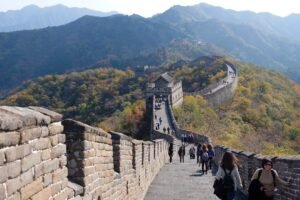China’s dynastic history is a tapestry woven with the threads of power, culture, and innovation, spanning thousands of years. The narrative of these dynasties is not merely a chronicle of rulers and their reigns; it is a reflection of the evolution of Chinese society, philosophy, and governance. Each dynasty has left an indelible mark on the fabric of Chinese identity, contributing to the rich cultural heritage that continues to influence the world today.
From the early formations of statehood to the complexities of imperial rule, the dynasties of China have shaped not only the nation but also the course of human history. Understanding China’s dynastic history is essential for grasping the nuances of its contemporary society. The legacies of these dynasties are evident in modern Chinese culture, politics, and social structures.
As we delve into the various dynasties, we will uncover the achievements and challenges that defined each era, revealing how they collectively forged a nation that stands as one of the oldest continuous civilisations on Earth. Start learning Chinese today at the LC Chinese School in Oslo.
Table of Contents
ToggleSummary
- China’s dynastic history is a rich tapestry of political, cultural, and technological advancements spanning over 3,000 years.
- The Xia Dynasty is the first recorded dynasty in China, marking the beginning of a long line of ruling families.
- The Shang Dynasty is known for its early Chinese civilization and the use of oracle bones for divination and communication with ancestors.
- The Zhou Dynasty introduced feudalism, Confucianism, and Taoism, shaping Chinese society and philosophy for centuries to come.
- The Qin Dynasty established the first imperial dynasty in China and built the iconic Great Wall, a symbol of Chinese strength and unity.
The Xia Dynasty: China’s First Recorded Dynasty
The Xia Dynasty, often regarded as China’s first recorded dynasty, is shrouded in a veil of myth and legend. Traditionally dated from around 2070 to 1600 BCE, it marks the beginning of China’s historical narrative. The existence of the Xia is primarily documented through ancient texts such as the “Records of the Grand Historian” by Sima Qian, which blends history with folklore.
While archaeological evidence remains sparse, findings at sites like Erlitou suggest that the Xia may have been a significant political entity, characterised by early forms of urbanisation and social stratification. The Xia Dynasty is notable for its contributions to early Chinese culture and governance. It is believed to have established foundational practices in agriculture, metallurgy, and social organisation.
The legendary figure of Yu the Great, credited with controlling floods and promoting irrigation, exemplifies the dynasty’s emphasis on leadership and public service. Although much about the Xia remains speculative, its role as a precursor to subsequent dynasties underscores its importance in shaping China’s historical trajectory.
The Shang Dynasty: Early Chinese Civilisation and Oracle Bones
Following the Xia, the Shang Dynasty (c. 1600–1046 BCE) represents a significant leap in the development of early Chinese civilisation. This era is distinguished by its advancements in writing, metallurgy, and urban planning.
The Shang are particularly renowned for their use of oracle bones—inscribed animal bones and turtle shells used for divination. These artifacts not only provide insight into Shang religious practices but also mark one of the earliest forms of Chinese writing, laying the groundwork for future literary traditions. The Shang Dynasty’s capital cities, such as Anyang, reveal a sophisticated society with complex social hierarchies and impressive architectural achievements.
The presence of bronze vessels and weapons indicates a high level of craftsmanship and technological innovation. Moreover, the Shang’s pantheon of gods and ancestral worship reflects a deep spiritual life that would influence Chinese culture for centuries to come. The legacy of the Shang Dynasty is thus pivotal in understanding the evolution of Chinese identity and governance.
The Zhou Dynasty: Feudalism, Confucianism, and Taoism
The Zhou Dynasty (c. 1046–256 BCE) is often heralded as a transformative period in Chinese history, marked by significant philosophical developments and political changes. This era introduced feudalism as a means of governance, where land was granted to nobles in exchange for loyalty to the king.
This decentralised system allowed for regional autonomy but also led to fragmentation and conflict among states, setting the stage for the Warring States period. Philosophically, the Zhou Dynasty was a fertile ground for ideas that would shape Chinese thought for millennia. Confucianism emerged during this time, advocating for moral integrity, social harmony, and respect for tradition.
In contrast, Taoism offered a more mystical approach to life, emphasising harmony with nature and the pursuit of simplicity. These two schools of thought would profoundly influence not only Chinese culture but also its political landscape, as rulers sought to embody Confucian virtues while navigating the complexities of governance.
The Qin Dynasty: The First Imperial Dynasty and the Great Wall of China
The Qin Dynasty (221–206 BCE) marks a pivotal moment in Chinese history as it represents the first unification of China under a centralised imperial rule. Led by Qin Shi Huang, this dynasty implemented sweeping reforms that standardised weights, measures, and even script across the vast territory. The establishment of a unified legal code laid the groundwork for future governance structures in China.
One of the most enduring legacies of the Qin Dynasty is the construction of the Great Wall of China. Initially built to protect against invasions from northern tribes, this monumental structure symbolises both military might and national unity. The Qin also initiated large-scale infrastructure projects, including roads and canals that facilitated trade and communication across regions.
Despite its relatively short duration, the Qin Dynasty’s impact on Chinese history is profound, setting precedents for imperial rule that would resonate through subsequent dynasties.
The Han Dynasty: Silk Road Trade and Confucianism
The Han Dynasty (206 BCE–220 CE) is often regarded as a golden age in Chinese history, characterised by economic prosperity and cultural flourishing. This era saw the expansion of trade routes known as the Silk Road, which connected China with distant lands such as Persia and Rome. The exchange of goods—including silk, spices, and precious metals—fostered not only economic growth but also cultural exchanges that enriched Chinese society.
Confucianism was further institutionalised during the Han period, becoming the official ideology that guided governance and education. The establishment of state-sponsored Confucian academies ensured that future generations were steeped in these values, promoting social harmony and ethical leadership. The Han Dynasty’s advancements in technology, such as papermaking and seismology, alongside its contributions to literature and art, solidified its reputation as one of China’s most illustrious dynasties.
The Tang Dynasty: Golden Age of Chinese Poetry and Buddhism
The Tang Dynasty (618–907 CE) is often celebrated as a pinnacle of cultural achievement in China, particularly in poetry and art. This era produced some of China’s most revered poets, including Li Bai and Du Fu, whose works continue to resonate with readers today. The Tang period was marked by an openness to foreign influences, particularly from Central Asia and beyond, which enriched its cultural landscape.
Buddhism flourished during the Tang Dynasty, becoming deeply integrated into Chinese society. Temples were constructed across the empire, serving as centres for worship and learning. The synthesis of Buddhist thought with indigenous philosophies like Confucianism and Taoism led to unique developments in Chinese spirituality and ethics.
The Tang Dynasty’s legacy is thus one of artistic brilliance and philosophical depth, leaving an enduring imprint on Chinese culture.
The Song Dynasty: Neo-Confucianism and Technological Advancements
The Song Dynasty (960–1279 CE) is notable for its remarkable technological advancements and economic growth. Innovations such as gunpowder, printing techniques, and advancements in agriculture transformed daily life and contributed to a burgeoning economy. The period also witnessed an increase in urbanisation as cities expanded rapidly due to trade and commerce.
Neo-Confucianism emerged during this time as a response to Buddhism’s influence on Chinese thought. This philosophical movement sought to reinterpret Confucian teachings in light of new ideas while emphasising moral self-cultivation and social responsibility. The Song Dynasty’s commitment to education led to an increase in literacy rates and scholarly pursuits, fostering a vibrant intellectual environment that would shape future generations.
The Yuan Dynasty: Mongol Rule and Marco Polo’s Travels
The Yuan Dynasty (1271–1368 CE), established by Kublai Khan, represents a unique chapter in Chinese history marked by Mongol rule. This period was characterised by significant cultural exchanges between East and West due to increased trade along the Silk Road. Marco Polo’s travels during this time brought Western attention to China’s wealth and sophistication, introducing European audiences to its vast landscapes and rich traditions.
Despite being ruled by foreign conquerors, the Yuan Dynasty saw a flourishing of arts and culture as Mongol leaders embraced many aspects of Chinese civilisation. This era also witnessed advancements in theatre and literature that reflected both Mongolian influences and traditional Chinese themes. However, tensions between Mongols and Han Chinese eventually led to discontent that would culminate in uprisings against Mongol rule.
The Ming Dynasty: Zheng He’s Voyages and the Forbidden City
The Ming Dynasty (1368–1644 CE) is renowned for its remarkable achievements in exploration and architecture. One of its most notable figures was Admiral Zheng He, whose maritime expeditions expanded China’s influence across Southeast Asia and beyond. These voyages not only facilitated trade but also established diplomatic relations with various kingdoms along his routes.
The construction of the Forbidden City in Beijing stands as a testament to Ming architectural prowess and imperial grandeur. This sprawling complex served as the political heart of China for centuries, symbolising both power and isolation from common society. The Ming era was marked by cultural revival; literature flourished alongside advancements in painting and ceramics that continue to be celebrated today.
The Qing Dynasty: Manchu Rule and the Opium Wars
The Qing Dynasty (1644–1912 CE), established by Manchu rulers, represents the last imperial dynasty in China’s long history. This period was marked by territorial expansion but also faced significant challenges from foreign powers. The Opium Wars in the 19th century highlighted China’s struggles against Western imperialism, leading to significant social upheaval and loss of sovereignty.
Despite these challenges, the Qing Dynasty also saw cultural achievements such as advancements in literature and art forms like Peking opera. However, internal strife culminated in revolts that ultimately led to the dynasty’s downfall in 1912. The Qing era serves as a poignant reminder of both China’s resilience in preserving its cultural identity amidst external pressures and its ongoing journey towards modernisation.
In conclusion, China’s dynastic history is a rich narrative filled with triumphs and tribulations that have shaped its identity over millennia. Each dynasty contributed uniquely to China’s cultural heritage while laying foundations for future developments in governance, philosophy, art, and trade. As we reflect on this vast historical landscape, it becomes increasingly important to engage with contemporary Chinese culture through language learning.
At LC Chinese School in Oslo, students can immerse themselves in Mandarin courses designed to foster understanding not only of language but also of China’s rich historical context. By learning Mandarin at LC Chinese School, students gain invaluable insights into China’s past while equipping themselves with skills that are essential for navigating today’s global landscape—an opportunity that connects them with one of humanity’s oldest civilisations while preparing them for future interactions with this dynamic nation.
Start learning Chinese today at the LC Chinese School in Oslo









